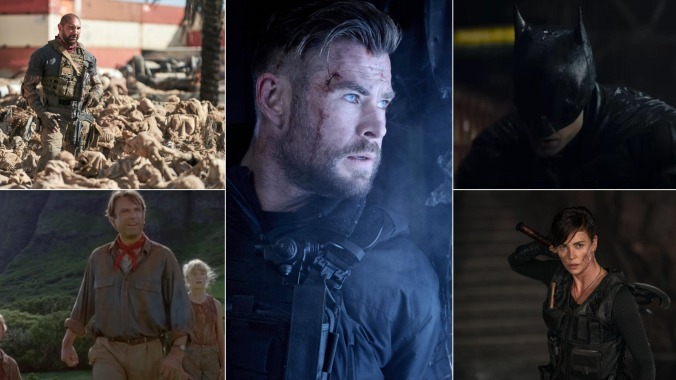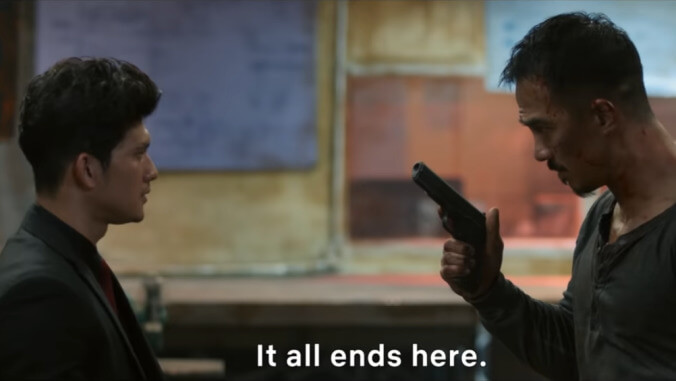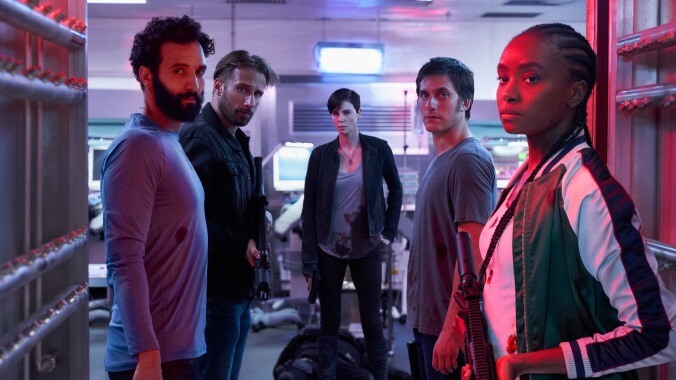The best action movies on Netflix right now
RRR, The Woman King, and The Batman help make Netflix the place to go for all the running, punching, shooting, and exploding you could possibly want

Remember the good ol’ days when you could see all the Christopher Nolan Batman films on Netflix? Well, those days are over. And remember the good ol’ days when you could watch a whole bunch of James Bond adventures on Netflix? Well, those days are over, too. So what’s left on Netflix that hasn’t been reunited with its corporate parent or escaped to another streamer? Plenty, as it turns out. Especially when it comes to the action adventure genre. We’ve scoured Netflix’s menus to round up the best action films currently on the service. If you want a more expansive inventory of their offerings, check out our list of the best movies on Netflix. We created the following rock ’em, sock ’em rundown because we thought action films deserved their own spotlight.
Looking for other movies to stream? Check out our list of the best movies on Netflix, best movies on Disney+, and best movies on Hulu.
This list was most updated January 30, 2024.

Remember the good ol’ days when you could see all the Christopher Nolan Batman films on Netflix? Well, those days are over. And remember the good ol’ days when you could watch a whole bunch of James Bond adventures on Netflix? Well, those days are over, too. So what’s left on Netflix that hasn’t been reunited with its corporate parent or escaped to another streamer? Plenty, as it turns out. Especially when it comes to the action adventure genre. We’ve scoured Netflix’s menus to round up the best action films currently on the service. If you want a more expansive inventory of their offerings, check out our list of the . We created the following rock ’em, sock ’em rundown because we thought action films deserved their own spotlight. Looking for other movies to stream? Check out our list of the , , and .This list was most updated January 30, 2024.
It has a big cast, but never feels overstuffed the way Zach Snyder’s did. Maybe that’s because the characters here are all flavorful archetypes with backstories easily conveyed in visual shorthand or quick snippets of dialogue. Or maybe it’s that the director (who co-wrote the script with Shay Hatten and Joby Harold) treats his plot like the derivative pulp it is, instead of like mythology transcribed from stone tablets. This is a long movie, but it doesn’t feel long. It moves, Snyder bounding with enthusiasm and little shame through clichés of his mashed-up video-store fare, like the moment where he walks us through—with a snappy illustrative flood of imagery—how the heist is supposed to unfold, which is to say how it won’t. Army’s general adherence to convention makes its deviations stand out. It’s a zombie movie with such enjoyable wrinkles in lore as a resurrected representative of the late Siegfried & Roy’s act, and a “hibernation stage” that turns crossing an infested lobby into a round of the quiet game with Bellagio-high stakes. Snyder just seems to be having genuine fun. Even when queuing up a sad pop jam (guess which Cranberries hit gets an acoustic rendition?) or slowing the motion to the speed of an Aquaman strut, Army Of The Dead possesses few traces of the dreary self-importance that sinks his superhero epics. In fact, this unlikely liberation from that mode even hints at an auto-critique, putting the king of the dead in a cape and helmet, like some lurching refugee from a genre that’s entered creative rigor mortis. But maybe that’s overthinking the matter. George Romero’s work aside, sometimes a zombie is just a zombie. []
What actually sets apart from other mainstream action movies is the sadistic gnarliness of the violence, which appears heavily inspired by Indonesian action flicks like The Raid, The Raid 2, and The Night Comes For Us. Throats are crushed, necks are snapped, and blood periodically gushes on the lens. The first fight scene in the film, in which an unarmed Tyler dispatches a room full of assailants with whatever’s at hand, is grisly and actually pretty fun. He even kills a man with a rake, though the movie sadly spares us what should be a well-earned one-liner. The real difference between the film and its likely influences is that the Indonesian offerings are martial arts movies at heart, which is to say they involve fights with skilled combatants. Extraction, however, sticks to the American model of body counts. []
As in Extraction, the action sequences in are the whole game here, and they do not disappoint. There’s a helicopter landing on a train, lengthy car chases, some North By Northwest-inspired dangling from a ledge, and innumerable room-full-of-killers mano a mano fight scenes. Most of these are done in what appear to be impossibly long single shots. The prior film had an 11-minute take; this time, one shot nearly doubles that. To the filmmakers’ credit, they admit that they used some editing trickery to achieve that effect. But these sequences are nonetheless truly impressive; you watch in amazement as the complicated fight choreography, involving dozens of stunt men and hundreds of gunshots and explosions, goes on and on. []

Nothing about Timo Tjahjanto’s career has been measured. The writer-director’s full-length debut, Macabre (co-directed with Kimo Stamboel and based on their award-winning short, “Dara”), is a grisly slasher, the first Indonesian film ever to be banned in Malaysia for “excessive violence.” It seemed a new master of horror was on the rise. After teaming twice more with Stamboel, Tjahjanto struck out on his own with , an organized-crime yarn that proves the director to be among the finest purveyors of can-you-top-this mayhem working today. What first comes across like it’s going to be Tjahjanto’s homage to Asian gangster movie royalty like John Woo and Johnnie To quickly reveals itself to be a madcap bloodbath, more in line with the wilder tendencies of Takashi Miike. While cut from the same stylistic cloth, Evans has slowly gravitated toward more operatic bombast (, ), whereas Tjahjanto’s proclivities have remained laser-focused: The messier, more gruesome, and more uproariously chaotic, the better. []

With , Love & Basketball and Beyond The Lights director Gina Prince-Bythewood helms an action-fantasy hybrid that takes the beauty marks—and warts—of each genre and creates a sequel-starter for Netflix. The film follows an idealistic cadre of heroes who all share a common thread: They can live for centuries. The titular group is led by Andy (Charlize Theron), with Booker (Matthias Schoenaerts), Joe (Marwan Kenzari), and Nicky (Luca Marinelli) making up the rest of the crew. When a new immortal warrior, Nile (Kiki Layne), joins them, she sparks a reckoning with the Guard’s ideals—and the rosy picture they try to uphold. Early in the film, Andy gifts Booker with a copy of Cervantes’ Don Quixote, which makes sense: A novel whose central ethic is individual goodness amid an errant society fits right in among this league of extraordinary Samaritans. The Guard has been around for ages, fighting (and dying) for humankind. At some point, they each found others like them, and banded together to secretly rescue humanity from itself ad nauseam. From stopping nuclear bombs to rescuing child hostages, Andy and company are guardians of the same mortals who would detest them if their powers were found out. The rub is that there’s a cap on their so-called immortality—one day, wounds just stop healing. It’s at this point that this superhero movie becomes a changing-of-the-guard Western, ruminating on what we leave to the next generation and what ideals it prioritizes. []
Gareth Evans’ Indonesian martial-arts throwback has a look and feel that resembles the best of ’80s cult action movies: half , half John Woo. It’s all grainy and underlit, with shots framed just tight enough to keep the audience from seeing how little of the set has been dressed. Meanwhile, Mike Shinoda and Joseph Trapanese’s score (added to the U.S. version) is moody and synthetic, more like sound effects than music. The Raid is not some ironic or tongue-in-cheek retro exercise, like Machete or Hobo With A Shotgun. Evans is using old-school methods to make an old-school movie, out of a deep respect for unapologetic badassery. Of course, “story” isn’t what most people will be looking for from The Raid: Redemption, which is first and foremost an orgy of violence. Bullets, fists, and blades all fly, captured by Evans via a constantly moving, frequently gravity-defying camera. The emphasis here is speed: The fight choreography is blisteringly quick, designed to make viewers gasp, and then cheer. The only real knock against the film is that there’s no real variation in tone or plot from start to finish. Watch any given 15 minutes of The Raid and you’ve pretty much seen The Raid. But why would you only watch 15 minutes? []
Full of colorful heroes, fiendish villains, staggering action sequences, dizzying dance numbers, and most of all, virtuous friendship, driven by feverish creativity and a sharp and unambiguous sense of pride for India’s people and their history, writer-director S. S. Rajamouli’s Telugu-language epic quickly became the word-of-mouth sensation of the year. Its relentless capacity to please crowds, first in its initial release, then special-event screenings, and finally, as a part of Netflix’s streaming library (albeit in a different language), has catapulted it from appealing counterprogramming to a tremendous and seemingly indefatigable international sensation. While it’s undeniably a product of the film community, and industry, for which it was originally conceived, its growing and deserved success underscores the expansion of cinema as a platform for exploring different cultures and different traditions, as well as for the universality of a well-told story. []

Don’t let the “Orphan Black knockoff” vibes sway you from checking out , a baldly silly yarn, set in a a future where environmental devastation has led to a strict global “one child per family” law. Noomi Rapace stars as seven identical septuplets named Monday, Tuesday, Wednesday, etc.; each leaves the house one day a week, all under the same shared identify, which of course has disastrous consequences. The main draw is seeing Rapace pull off the delightful juggling act of seven different personalities, but director Tommy Wirkola (Dead Snow) also orchestrates gleefully over-the-top action and chase sequences. He’s staged a crowd-pleasing game of cat-and-mouse, jazzed up by sci-fi flourishes and a high concept. []
The truly terrific performances—especially from Viola Davis—and the effective battle scenes deliver in the thrills in . (The MPAA rating keeps it way, way less bloody than a typical Sunday night on HBO.) Most striking is the overall look of this film, a production designed to rebuke colonialist notions of Africa, the “dark continent.” The architecture of the King’s palace is richly designed, brimming with color and intricate decorative elements. Rarely does one watch a movie and think “great lighting!” but director Gina Prince-Bythewood and cinematographer Polly Morgan earned it here. Also, the costumes (from Star Trek: Discovery alum Gersha Phillips) are extraordinary, weaving fierce looks with fiercer weapons. Why would Lashana Lynch want a rifle when she can file her fingernails into instruments of death? The Woman King’s training scenes are more upbeat than most war pictures (think Stripes instead of Full Metal Jacket) and some of the scenes “at court” (especially with the King’s eunuch majordomo) have a fun Game Of Thrones quality. Prince-Bythewood, whose Beyond The Lights is one of the most overlooked movies of the last decade, has created a vision of historical Africa that has truly never been seen in a mainstream American movie. For that alone, she deserves a crown. []
Spy Kids is one of those ideas someone was bound to come up with eventually, a combination of two words that, in the right hands, reads like a license to print money. It’s no wonder, then, that franchise creator Robert Rodriguez produced four mid-budget Spy Kids features over the course of a decade, and they collectively earned more than half a billion dollars worldwide.But there’s more to Spy Kids than just taking a couple of cute children and giving them gadgets to play with. These movies are at their best when they say something about family and how kids see the world. So, along comes , the first reboot in the franchise’s history, and the first Spy Kids movie in more than a decade, to attempt to do just that. The results are, perhaps unsurprisingly for a Netflix kids adventure, a bit mixed, but in the hands of Rodriguez and his son and co-writer Racer Max, this latest installment in the series is a very pleasant family adventure, provided you’re willing to meet the film on its terms. []
The Batman has some of the rain-slicked neon dreariness of a David Fincher procedural, but it’s still set in an outsized comic-book world of good guys and bad guys. It’d be difficult to call any of these iterations of the characters definitive, even as most of them are played by first-rate actors. Zoë Kravitz brings an uncommon emotional realism to Catwoman, reimagined here as a nightclub waitress with a vendetta against the mob. The lack of va-va-voom campiness is less detrimental than the way the script jettisons this classic anti-heroine’s usual shifting allegiances and moral ambiguities. She’s nearly as on-the-level as a pre-promotion Jim Gordon (Jeffrey Wright)—and less interesting for it. And then there’s Colin Farrell as fellow heavy The Penguin, still a low-flying bird in Gotham’s criminal pecking order. Unrecognizable under mounds of Dick Tracy prosthetics and a goombah accent, Farrell is mostly a hoot. But it’s a glorified cameo. []
In a lot of ways, Jurassic Park marks a truly magical moment in the history of cinematic illusion. Computer-generated images had only just started to appear in big, mainstream films, and often clumsily, as in the psychedelic virtual-reality gimmickry of , or even to enhance the hand-drawn animation in . had made computer imagery seem spectacular, in part by limiting it to brief flashes of screen time and by using it to render something truly alien. But in Jurassic Park, Spielberg uses those computers to illustrate things that every kid in the audience had imagined a million times, transforming them into something tangible. []
Not since has a movie gotten as much mileage out of having its hero fuck up as The Nice Guys does. Shane Black’s entertaining but shaggy homage to -era detective series and mid-to-late 1970s cheese finds its offbeat gumshoe in Holland March (Ryan Gosling), a smartass with no sense of smell who tends to make bad guesses, lose guns, misread addresses, drink whatever’s handed to him, and defenestrate himself repeatedly; early on, he tries to break into a window, only to slice his wrist up so badly that he passes out from blood loss. Structured like a TV pilot, the movie partners March with Jackson Healy (Russell Crowe), the Yoo-hoo-loving goon who broke the private eye’s arm just days before, in the search for a missing activist. []
There is some craftsmanship here, too, that is hard not to admire—for instance, the way Villeneuve manages to balance a large, effects-heavy battle scene (which he directs with aplomb) with simultaneous intrigue inside the Atreides compound by making the interior sets big and cavernous. This gift for visual dimension is key, because what Dune offers, despite its often monochromatic futurism, is a kind of entertainment that was a far older Hollywood’s stock-in-trade: that of stars and titanic spectacle. In an odd way, the movie feels like an update of a Cinemascope epic, with impressive vistas, an overall sense of exotic grandeur, and a deliberate pace. []
